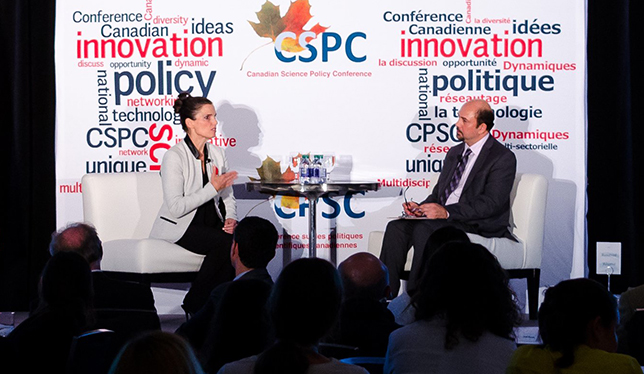“Let me begin by addressing what might be on your minds,” said the federal minister of science, Kirsty Duncan, in a keynote speech on Nov. 2 to a room full of researchers, academics, funders and policy-makers at the Canadian Science Policy Conference in Ottawa. “The call for more funding for science,” she continued, “this has been and will continue to be a priority for me.”

Dr. Duncan reiterated her efforts to increase diversity and equity in science and discussed changes she’s made two years into her mandate. She also addressed the calls to action of the Fundamental Science Review (also known as the Naylor report) she commissioned in 2016. “I agree with the majority of the recommendations and I’m taking action to implement many of them,” Dr. Duncan said, emphasizing her focus on “investigator led” research.
Earlier that day, Dr. Duncan announced changes to the Canada Research Chairs program, capping the Tier 1 chairs to a maximum of two seven-year terms; and allowing universities more flexibility, from now until December 2019, to convert between Tier 1 and Tier 2 chairs, and across disciplines, to increase the diversity of chairholders. The changes come in response to the Naylor report and also on the advice of a 15-year evaluation of the CRC program. A separate initiative will see universities submitting action plans to meet CRC diversity targets by December of this year, to be met by 2019.
A week earlier, on Oct. 27, the government announced the establishment of the Canada Research Coordinating Committee, with a mandate to harmonize programs and policies among granting councils and the Canada Foundation for Innovation. The members of the CRCC are to submit a work plan in the next two months to “map out how they will address such issues as Canada’s capacity to support international, multidisciplinary, risky and rapid-response research; how we can collectively advance our efforts to support Canada’s strengths in strategic research areas; and what more can be done to increase equity and diversity and improve support to early career researchers,” Dr. Duncan said. She also said that she has “expressed support for replacing the science, technology and innovation council with a more public-facing advisory body.”
In terms of other achievements, Dr. Duncan pointed to the recent appointment of Mona Nemer as Canada’s chief science advisor, and the reinstatement of the long-form census and UCASS (the University and College Academic Staff System) survey, the latter of which will be extended to college and part-time faculty.
Speaking to what she acknowledged as “the elephant in the room,” Dr. Duncan raised the issue of research funding throughout the evening. (Among its 35 recommendations, the Naylor report advised that the federal government increase research-related spending from approximately $3.5 billion to $4.8 billion over four years, and that the Canada Foundation for Innovation be given a stable, annual budget of around $300 million.)
“It is a big ask,” Dr. Duncan said. “Is it something we can do in one budget? In one mandate? The previous government dug a big hole; it’s going to take time to fix, but you have someone who’s the champion for you.” She also urged the research community to “tell the stories of science” and its impact to the Canadian public.
The following day at the science conference, four members of the Fundamental Science Review panel – including the panel chair, former University of Toronto president David Naylor – spoke about progress on the report to date. Referring to Dr. Duncan’s address the day before, Dr. Naylor said: “I thought it was a very useful tone-setting speech that highlighted what is being done.” If one reflects back on other such reports, he said, it often takes “months to years to get acted on.” By comparison, the government is “moving at a pretty good clip. I wish they’d move faster, but things are moving in an impressive way, and I thought she broadcasted that well.”
From a student’s perspective, “the minister’s remarks were what we would have expected, but we were hoping for more in terms of a signal for the government to reinvest meaningfully in fundamental research,” said Vanessa Sung, a PhD student in biochemistry at McGill University, in an interview. Ms. Sung is co-president, with Shawn McGuirk, of the Science & Policy Exchange, a Montreal-based advocacy group run by students who coined the hashtag #Students4theReport. “A lot of grant dollars from the granting agencies go toward salary support for students and research staff,” Ms. Sung said. “She’s right, it is a big ask and we are in a big hole, but the recommendation for the funding increase is designed so that it can be implemented over four years. It’s an incremental increase.”